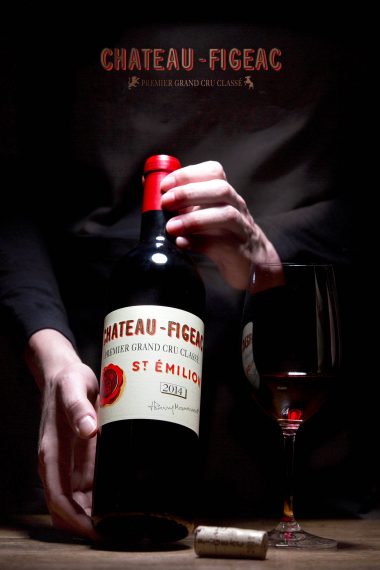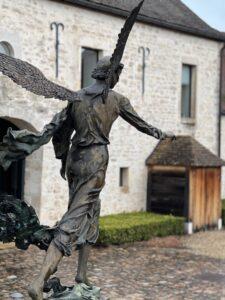Château Figeac: Saint-Émilion Excellence
Can you imagine what it would be like to be invited to a private dinner inside a historic chateau?
It must have been a decade now since I was a guest for dinner, hosted by the Manoncourt family, treated to an evening of stories and their fantastic wines.
Located in the historic region of Saint-Émilion in Bordeaux, Château Figeac stands among the pinnacles of fine French winemaking.
With roots that stretch back to Gallo-Roman times and a continuous family stewardship for well over a century, the estate has earned a place in the pantheon of Bordeaux’s finest wines.
Its recent elevation in 2022 to Premier Grand Cru Classé A—the highest recognition in the Saint-Émilion classification—has cemented its position as an iconic label producing iconic wine.

A Rich Tapestry of History
The story of Château Figeac begins remarkably early, tracing its name to the Figeacus family of the 2nd century AD who established a villa on what is now the estate’s grounds.
Through centuries of transformation, subdivision, and renewal, the property took shape in the 19th century, when Henri de Chevremont purchased it in 1892.
It later passed through his daughter to the Manoncourt family, who have been its stewards ever since.
Thierry Manoncourt
A turning point came in 1947 when Thierry Manoncourt began reshaping the estate.
Under his direction, Château Figeac rose to prominence, combining scientific precision with an unwavering devotion to terroir and tradition.
Following his death in 2010, his widow Marie-France Manoncourt and their family continued his legacy, bolstered by renewed leadership under CEO Frédéric Faye.
Terroir Beyond Compare
Château Figeac’s uniqueness begins in the soil.
Most estates in Saint-Émilion—especially those situated on the limestone-rich plateau—are dominated by Merlot.
However, Figeac defies the norm. Located on the western edges of the appellation near the Pomerol border, the estate’s terroir comprises three Gunzian gravel outcrops made of quartz and flint, a rare geological formation in the area.
This gravel, laid atop iron-rich blue clay, offers excellent drainage and reflects heat, enabling the successful cultivation of grapes typically associated with the Left Bank of Bordeaux, Cabernet Sauvignon and Cabernet Franc.
Figeac’s 41 hectares of vineyards are planted to 35% Cabernet Sauvignon, 35% Cabernet Franc, and 30% Merlot—a composition unique in Saint-Émilion.
The vineyard’s average vine age is around 40 years, with several parcels boasting venerable plants over 100 years old.
Sustainable Viticulture and Winemaking Innovation
Beyond its geological assets, Château Figeac upholds a strong commitment to sustainability.
The estate is certified HVE 3 (Haute Valeur Environnementale – Level 3), the highest environmental certification in France.
Château Figeac embraces modern vinification methods without sacrificing tradition. The program is overseen by Michel Rolland, one of Bordeaux’s most legendary consulting enologists.
His influence, combined with the technical expertise of Romain Jean Pierre and cellar master Jean Albino, ensures the estate’s wines encapsulate precision, depth, and grace.
In line with this philosophy, the grand vin is aged in 100% new French oak barrels, adding structure and complexity to an already layered profile.
Architectural Renaissance
One of the estate’s most significant modern projects was the construction of new winemaking facilities, unveiled between 2018 and 2021.
This three-level, 5,000-square-meter cellar extends 12 meters underground and reflects a seamless marriage of high technology and elegant design.
It was constructed to improve the vinification process, ensuring the utmost respect for the grape’s potential, from harvest to bottle.
This meticulous effort allows Château Figeac to tailor fermentation vessel size to each parcel, preserve each lot’s identity, and ultimately blend a wine that’s greater than the sum of its parts.
The result is a wine that offers the signature Figeac experience: refined, bright, and unmistakably aristocratic.
A Benchmark Wine
Tasting Château Figeac is a study in harmony. The wine’s distinctive blend leans into the power and structure of Cabernet Sauvignon, the perfumed elegance of Cabernet Franc, and the plush fruitiness of Merlot.
It yields an aromatic, complex bouquet—notes of cassis, graphite, violet, tobacco, and spice all gracefully interwoven.
On the palate, it is a wine of depth and precision, with silky tannins and a remarkably persistent finish that speaks of its elite pedigree.
The wine’s aging potential is another hallmark.
In top vintages, Château Figeac can evolve and improve for several decades. Wine critics and collectors frequently praise its ability to develop nuanced secondary and tertiary aromas over time, rewarding those with the patience to cellar it.

A Rich Tapestry of History
The story of Château Figeac begins remarkably early, tracing its name to the Figeacus family of the 2nd century AD.
They had established a villa on what is now the estate’s grounds.
Through centuries of transformation, subdivision, and renewal, the property took shape in the 19th century. This is when Henri de Chevremont purchased it in 1892.
It later passed through his daughter to the Manoncourt family. They have been its stewards ever since.
Thierry Manoncourt
A turning point came in 1947 when Thierry Manoncourt began reshaping the estate.
Under his direction, Château Figeac rose to prominence, combining scientific precision with an unwavering devotion to terroir and tradition.
Following his death in 2010, his widow Marie-France Manoncourt and their family continued his legacy, bolstered by renewed leadership under CEO Frédéric Faye.
Terroir Beyond Compare
Château Figeac’s uniqueness begins in the soil.
Most estates in Saint-Émilion—especially those situated on the limestone-rich plateau—are dominated by Merlot.
However, Figeac defies the norm. Located on the western edges of the appellation near the Pomerol border, the estate’s terroir comprises three Gunzian gravel outcrops made of quartz and flint, a rare geological formation in the area.
This gravel, laid atop iron-rich blue clay, offers excellent drainage and reflects heat.
This allows for the successful cultivation of grapes typically associated with the Left Bank of Bordeaux: Cabernet Sauvignon and Cabernet Franc.
Figeac’s 41 hectares of vineyards are planted to 35% Cabernet Sauvignon, 35% Cabernet Franc, and 30% Merlot—a composition unique in Saint-Émilion.
The vineyard’s average vine age is around 40 years, with several parcels boasting venerable plants over 100 years old.
Sustainable Viticulture and Winemaking Innovation
Beyond its geological assets, Château Figeac upholds a strong commitment to sustainability.
The estate is certified HVE 3 (Haute Valeur Environnementale – Level 3), the highest environmental certification in France.
Château Figeac embraces modern vinification methods without sacrificing tradition. The program is overseen by Michel Rolland, one of Bordeaux’s most legendary consulting enologists.
His influence, combined with the technical expertise of Romain Jean Pierre and cellar master Jean Albino, ensures the estate’s wines encapsulate precision, depth, and grace.
In line with this philosophy, the grand vin is aged in 100% new French oak barrels, adding structure and complexity to an already layered profile.
Architectural Renaissance
One of the estate’s most significant modern projects was the construction of new winemaking facilities, unveiled between 2018 and 2021.
This three-level, 5,000-square-meter cellar extends 12 meters underground and reflects a seamless marriage of high technology and elegant design.
It was constructed to improve the vinification process, ensuring the utmost respect for the grape’s potential, from harvest to bottle.
This meticulous effort allows Château Figeac to tailor fermentation vessel size to each parcel, preserve each lot’s identity, and ultimately blend a wine that’s greater than the sum of its parts.
The result is a wine that offers the signature Figeac experience: refined, bright, and unmistakably aristocratic.
A Benchmark Wine
Tasting Château Figeac is a study in harmony. The wine’s distinctive blend leans into the power and structure of Cabernet Sauvignon, the perfumed elegance of Cabernet Franc, and the plush fruitiness of Merlot.
It yields an aromatic, complex bouquet—notes of cassis, graphite, violet, tobacco, and spice all gracefully interwoven.
On the palate, it is a wine of depth and precision, with silky tannins and a remarkably persistent finish that speaks of its elite pedigree.
The wine’s aging potential is another hallmark.
In top vintages, Château Figeac can evolve and improve for several decades.
Wine critics and collectors frequently praise its ability to develop nuanced secondary and tertiary aromas over time, rewarding those with the patience to cellar it.




